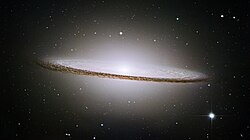Сурет:Sombrero Galaxy in infrared light (Hubble Space Telescope and Spitzer Space Telescope).jpg

Бұл алдын ала көрудің өлшемі: 800 × 448 пиксел. Басқа ажыратылымдықтар: 320 × 179 пиксел | 640 × 359 пиксел | 1024 × 574 пиксел | 1280 × 717 пиксел | 3000 × 1681 пиксел.
Түпнұсқа файл (3000 × 1681 пиксел, файл өлшемі: 3,98 MB, MIME түрі: image/jpeg)
Файл тарихы
Файл сол кезде қалай көрінгенін көру үшін күн/уақыт дегенге басыңыз.
| Күн/Уақыт | Нобай | Өлшемдер | Қатысушы | Пікір | |
|---|---|---|---|---|---|
| қазіргі | 01:46, 2009 ж. шілденің 21 |  | 3000 × 1681 (3,98 MB) | Tryphon | {{Information |Description=NASA/ESA Hubble Space Telescope and NASA's Spitzer Space Telescope joined forces to create this striking composite image of one of the most popular sights in the universe. Messier 104 is commonly known as the Sombrero galaxy bec |
Файл қолданылуы
Бұл файлды мына бет қолданады:
Глобалды файл қолданылуы
Бұл файл келесі басқа уикилерде қолданылады:
- ast.wikipedia.org жобасында қолданылуы
- az.wikipedia.org жобасында қолданылуы
- bs.wikipedia.org жобасында қолданылуы
- cs.wikipedia.org жобасында қолданылуы
- de.wikipedia.org жобасында қолданылуы
- en.wikipedia.org жобасында қолданылуы
- en.wikiquote.org жобасында қолданылуы
- en.wikiversity.org жобасында қолданылуы
- es.wikipedia.org жобасында қолданылуы
- fa.wikipedia.org жобасында қолданылуы
- frp.wikipedia.org жобасында қолданылуы
- fr.wikipedia.org жобасында қолданылуы
- he.wikipedia.org жобасында қолданылуы
- id.wikipedia.org жобасында қолданылуы
- it.wikibooks.org жобасында қолданылуы
- kn.wikipedia.org жобасында қолданылуы
- mg.wikipedia.org жобасында қолданылуы
- pl.wikipedia.org жобасында қолданылуы
- pt.wikipedia.org жобасында қолданылуы
- simple.wikipedia.org жобасында қолданылуы
- sk.wikipedia.org жобасында қолданылуы
Бұл файлдың глобалды қолданылуын көбірек көру.


